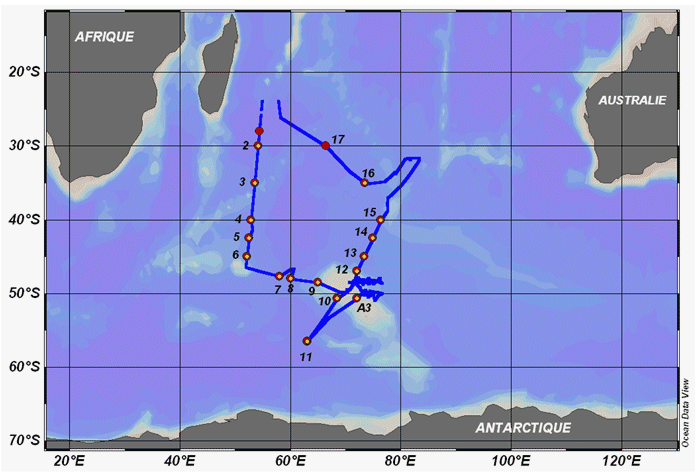VT 136 / OISO-23
| Type | Oceanographic cruise |
|---|---|
| Set | This cruise is part of the set OISO - OCÉAN INDIEN SERVICE D'OBSERVATION |
| Ship | Marion Dufresne |
| Ship owner | TAAF |
| Dates | 06/01/2014 - 19/02/2014 |
| Chief scientist(s) | LO MONACO Claire , METZL Nicolas  |
LABORATOIRE D'OCÉANOGRAPHIE ET DU CLIMAT : EXPÉRIMENTATIONS ET APPROCHES NUMÉRIQUES - UMR 7159 Institut Pierre Simon Laplace Boîte 100 4 place Jussieu 75005 Paris +33 (1) 44 27 32 48 |
|
| DOI | 10.17600/14002700 |
| Objective | The S.O. OISO (Indian Ocean observation service) aims to study the variability over time and space of air-sea exchanges of CO2 and the invasion of anthropogenic CO2 in the ocean in subtropical, sub-Antarctic and Southern Ocean zones. The OISO observations acquired aboard RV Marion-Dufresne (IPEV) since 1998 complement the measurements taken in other ocean sectors by French and foreign partners (http://www.ioccp.org/Underway/). These observations are crucial for assessing carbon budgets on a global scale (Kyoto protocol framework), to parameterize and then validate, predictive climate models (IPCC framework) and better understand the phenomenon of ocean acidification. The OISO22 aimed to repeat the measurements of CO2 and associated parameters along the logistics track of RV Marion Dufresne. As well as continuous surface measurements, observations were acquired on the water column at 17 OISO stations located along the entire route of the trip, as well as 2 KEOPS stations in the bloom to the East and South of Kerguelen. In addition to the usual parameters, samples were taken at most stations for the EXPLAIN project, whose objective is to link phytoplankton diversity to carbon export (led by I. Salter and S. Blain, LOMIC). Plankton foraminifera were also collected using a multinet in order to assess their role in the biological CO2 pump (SOforCO2 project, led by R. Schiebel, BIAF). Finally, daily samples were taken to determine the photosynthetic pigments in surface water, and this was done to validate and improve the algorithms used to detect the predominant phytoplankton species satellite (PHYSAT, led by S. Alvain, LOG, Univ. Lille). The related projects are LEFE/CyBER, CLIVAR/WCRP, SOLAS IMBER/IGBP, FP7/CARBOCHANGE. |


